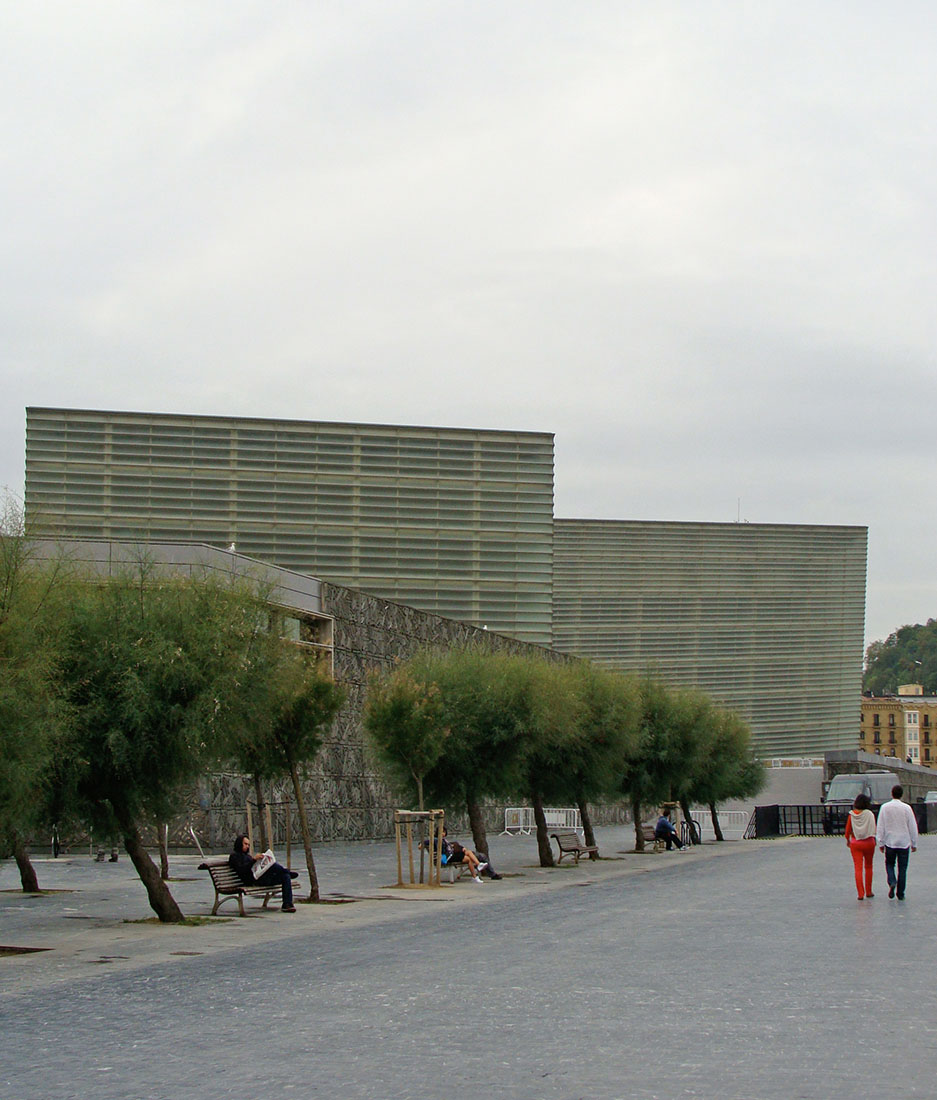 |
 |
 |
 |


Palacio de Congresos y Auditorio Kursaal
Avenida Zurriola 1, San Sebastián
1989 - 1999
Das Kursaal Auditorium mit Kongresszentrum (Palacio de Congresos y Auditorio
Kursaal) in San Sebastián
befindet sich direkt am Ufer, wo der Fluss Urumea in den Golf von
Biskaya mündet. Im Jahr 1989 hatte die Stadt sechs international
bekannte Architekten (Mario Botta, Norman Foster,
Arata Isozaki, Rafael Moneo,
Juan Navarro Baldeweg, and Luis Peña
Ganchegui) als technische Berater beigezogen. Im Folgejahr wurde der
Vorschlag von Rafael Moneo aus den sechs Entwürfen ausgewählt. Das
Ausführungsprojekt wurde zwischen 1991 und 1994 gezeichnet, 1995 wurde
es definitiv genehmigt und die Bauarbeiten begannen im Mai des selben
Jahres.
Die beiden markanten Glaskuben werden als das bezauberndste
Kongresszentrum Spaniens betrachtet. Mit ihren Fassaden aus
transluzentem Glas werden die Volumen als gestrandete Felsen
betrachtet. Der Architekt Rafael Moneo hat darauf verwiesen, dass er
die Geographie bewahren wollte und die Harmonie zwischen natürlich und
künstlich möglichst zu betonen versuchte. Nach der Fertigstellung wurde
das Ensemble mit dem Mies von der Rohe Preis ausgezeichnet, dem
wichtigsten europäischen Preis für zeitgenössische Architektur. In der
Preisverleihung wurde auf den ausserordentlichen Chrakter und die
konzeptionelle Ästhetik sowie auf technische und konstruktive
Innovationen verwiesen. Das Zentrum wurde 1999 eröffnet und hat sich
inzwischen zum wichtigsten Standort für öffentliche kulturelle
Ereignisse in San Sebastián
entwickelt. Das Ensemble enthält unter anderem einen Theatersaal,
Ausstellungsräumen und ein Kino. Der grösste Saal wird Auditorio
genannt und bietet 1800 Sitzplätze, die Sala de Cámara weist 600 Plätze auf. Eine grosse Tiefgarage bietet zudem zahlreiche Parkplätze für Strandbesucher. Jedes Jahr im September findet hier das 'Festival
Internacional
de Cine de Donosti' statt. Die beiden Glaskuben werden von einer
grosszügigen Terrasse mit Bar, Restaurant, Shops und Duschen umgeben.
Nachts wechseln die beiden Glaskuben ihre Erscheinung und werden zu
leuchtenden Körpern, zu Laternen am Strand. Zusammen mit dieser
Verwandlung verändert sich auch das Leben um die Kuben zu einem
vibrierenden Nachtleben.
The Kursaal Auditorium and Congress Centre (Palacio de Congresos y Auditorio Kursaal) in San Sebastián is located immediatle at the shore, where Rio Urumea meets the Bay of Biscay. In 1989, the Town Council invited six internationally renowned architects (Mario Botta, Norman Foster, Arata Isozaki, Rafael Moneo, Juan Navarro Baldeweg, and Luis Peña Ganchegui) for a Technical Consultation. The following year the proposal by Rafael Moneo was chosen among the six designs. The execution project was drawn between 1991 and 1994, in 1995, the project was definitely approved and the construction works started in May of that same year. The two characteristic glass cubes are regarded as the most enchanting congress centre in Spain. With their façades made of translucent glass, they are regarded as “two beached rocks”. The architect Rafael Moneo statetd, that he intended to perpetuate the geography and, to emphasize the harmony between the natural and the artificial as far as it was possible. After Completion, the building was awarded the Mies van der Rohe Prize, the most important European award for contemporary architecture. The project was honored for its exceptional character, its conceptual aesthetic as well as technical and constructive innovations. The Congress Centre was inaugurated in 1999 and became the most important location for public cultural events in San Sebastián. The complex contains among other features a theatre hall, exposition space and a cinema. The larges hall is called Auditorio and offers space 1800 persons, while the Sala de Cámara has 600 seats. A large underground parking offers numerous parking lots for those visiting the neighbouring beach. Every year in September the Kursaal houses the 'Festival Internacional de Cine de Donosti'. The two glass cubes are surrounded by a vast outdoor terrace with restaurant, bar, shops and showers. At night the two cubes change their appearance and become luminous volumes like lanterns at the beach. At the same time life around the ensemble changes and becomes the city's vibrant night-life.
The Kursaal Auditorium and Congress Centre (Palacio de Congresos y Auditorio Kursaal) in San Sebastián is located immediatle at the shore, where Rio Urumea meets the Bay of Biscay. In 1989, the Town Council invited six internationally renowned architects (Mario Botta, Norman Foster, Arata Isozaki, Rafael Moneo, Juan Navarro Baldeweg, and Luis Peña Ganchegui) for a Technical Consultation. The following year the proposal by Rafael Moneo was chosen among the six designs. The execution project was drawn between 1991 and 1994, in 1995, the project was definitely approved and the construction works started in May of that same year. The two characteristic glass cubes are regarded as the most enchanting congress centre in Spain. With their façades made of translucent glass, they are regarded as “two beached rocks”. The architect Rafael Moneo statetd, that he intended to perpetuate the geography and, to emphasize the harmony between the natural and the artificial as far as it was possible. After Completion, the building was awarded the Mies van der Rohe Prize, the most important European award for contemporary architecture. The project was honored for its exceptional character, its conceptual aesthetic as well as technical and constructive innovations. The Congress Centre was inaugurated in 1999 and became the most important location for public cultural events in San Sebastián. The complex contains among other features a theatre hall, exposition space and a cinema. The larges hall is called Auditorio and offers space 1800 persons, while the Sala de Cámara has 600 seats. A large underground parking offers numerous parking lots for those visiting the neighbouring beach. Every year in September the Kursaal houses the 'Festival Internacional de Cine de Donosti'. The two glass cubes are surrounded by a vast outdoor terrace with restaurant, bar, shops and showers. At night the two cubes change their appearance and become luminous volumes like lanterns at the beach. At the same time life around the ensemble changes and becomes the city's vibrant night-life.